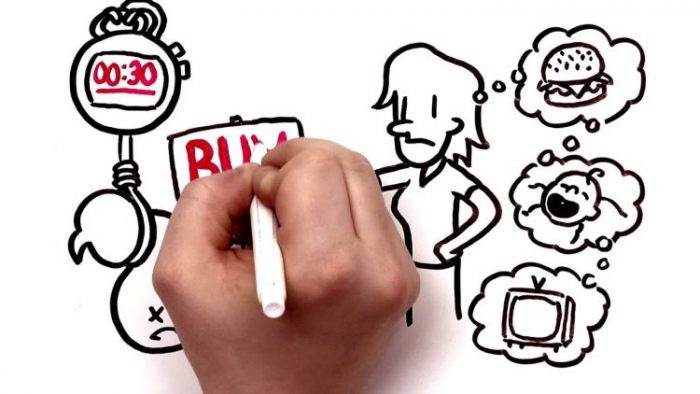What is a whiteboard video? The easy answer, whiteboard videos are videos of writing on a whiteboard. The narration is often included in whiteboard videos.
If you’re interested in creating a live video of your drawing on a whiteboard, then go ahead! This article is not for everyone. Live-action whiteboard videos are time-consuming to make from scratch.
This article explains how to create a whiteboard video with the software. Here’s a side-by-side example of an actual whiteboard video and a video using Sparkol Videoscribe.
Although software-drawn videos don’t have the same charm as live-action videos, they can be produced without the need for proper lighting, recording equipment, artistic skills, or the right technical support.
So, if you want to create your whiteboard animation videos such as this video on the 70:20:10 Framework, this article is for you! This video will show you how to make a whiteboard animation for eLearning.
Write Script of Your Story
Writing a script is the first step. Although the process of creating a script will vary depending on your needs, a script should be the final product. A script is not a blog post or essay. It should be a detailed description of what you intend to say during the video.
I prefer to read source material aloud, in the same way I would on stage. My script will reflect this. I may not be able to say everything, and I might simplify sentences and add more words.
Create Storyboard of the Script
Once you have written your script, it is time to start storyboarding. Some things are more difficult to visualize or demonstrate than others. Abstract concepts can be tricky, so don’t dwell on them. You should focus on visual cues that are memorable and reinforce your script.
The storyboarding phase is also where you decide how to organize your script onto a whiteboard. How do you move the frames? How does the frame move from one to another? How does each frame relate to the larger picture? These are all questions to consider when storyboarding.
Storyboard and script work together, sometimes overlapping but communicating distinct but related things.
Animate the Storyboard
Next, you need to create your storyboard according to your script. Storyboarding is the ideal stage. Animate is the execution stage. Your animation stage’s mechanics will vary depending on your platform and the icons you have, but this is where you tell your story.
Record Your Audio
Now that you have your script and animation, it is time to record your audio.
Audio for shorter videos is easier, more consistent, and flows better if done in one go. You can break it down if you wish, but that takes away the energy.
Two screens are used when recording audio. One screen has my script, and the other is the animation. It allows me to maintain my timing. Print your script if you don’t have enough screens.
For recording, I use a USB microphone such as the Snowball and Yeti. However, there are many options, including an iPhone (surprisingly high quality).
Try to be interesting with your voice. My videos are recorded as if I were giving a passionate presentation to small groups. It is the perfect opportunity to learn if you are a public speaker. There are many resources available for public speaking if you don’t have any.
Time The Animation
Timing of your animation means linking your animation to your script. Your animation’s timing and your script are where the magic happens. Are you looking for icons that appear right as you speak them?
Do you want icons to appear right when you say them? Or are they to sneak in as you talk, possibly countering your script? These are just a few of the art tools you have at your disposal to bring life and style to your video.
I will often speak in each frame, adjusting the timing and order of each element chronologically.
It is why it is so important to make sure your script matches what you are saying. Your animation may not be consistent if you constantly change how you present your points. You can update and change your script however often you wish, but it is important to stick with it for consistency.
Pro-tip you want your animation and script to match perfectly for a photo shoot but actually performing . It doesn’t need to be perfect . After you have recorded your audio, you can adjust the timing of your animation and audio to match (but don’t try to get it perfect; time issues that are too long will take a lot of time to fix).
